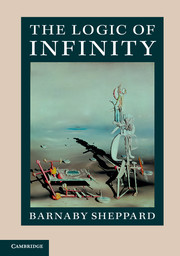Book contents
- Frontmatter
- Contents
- Preface
- Synopsis
- 1 Introduction
- 2 Logical foundations
- 3 Avoiding Russell's paradox
- 4 Further axioms
- 5 Relations and order
- 6 Ordinal numbers and the Axiom of Infinity
- 7 Infinite arithmetic
- 8 Cardinal numbers
- 9 The Axiom of Choice and the Continuum Hypothesis
- 10 Models
- 11 From Gödel to Cohen
- A Peano Arithmetic
- B Zermelo–Fraenkel set theory
- C Gödel's Incompleteness Theorems
- Bibliography
- Index
- Frontmatter
- Contents
- Preface
- Synopsis
- 1 Introduction
- 2 Logical foundations
- 3 Avoiding Russell's paradox
- 4 Further axioms
- 5 Relations and order
- 6 Ordinal numbers and the Axiom of Infinity
- 7 Infinite arithmetic
- 8 Cardinal numbers
- 9 The Axiom of Choice and the Continuum Hypothesis
- 10 Models
- 11 From Gödel to Cohen
- A Peano Arithmetic
- B Zermelo–Fraenkel set theory
- C Gödel's Incompleteness Theorems
- Bibliography
- Index
Summary
Primitive notions
The word ‘definition’ has come to have a dangerously reassuring sound, owing no doubt to its frequent occurrence in logical and mathematical writings.
–Willard van Orman QuineDefinitions – avoiding circularity
Some elementary observations have profound corollaries. Here is an example. Suppose finitely many points are distributed in some space and each point is joined to a number of other points by arrows, forming a complex directed network. We choose a point at random and trace a path, following the direction of the arrows, spoilt for choice at each turn. No matter how skillfully we traverse the network, and no matter how large the network is, we are forced at some stage to return to a point we have already visited. Every road eventually becomes part of a loop, in fact many loops.
A dictionary is a familiar example of such a network. Represent each word by a point and connect it via outwardly pointing arrows to each of the words used in its definition. We see that a dictionary is a dense minefield of circular definitions. In practice it is desirable to make these loops as large as possible, but this is a tactic knowingly founded on denial. The union of all such loops forms the core of the artificial language world of the dictionary, every word there in definable in terms of the loop members.
- Type
- Chapter
- Information
- The Logic of Infinity , pp. 1 - 184Publisher: Cambridge University PressPrint publication year: 2014



